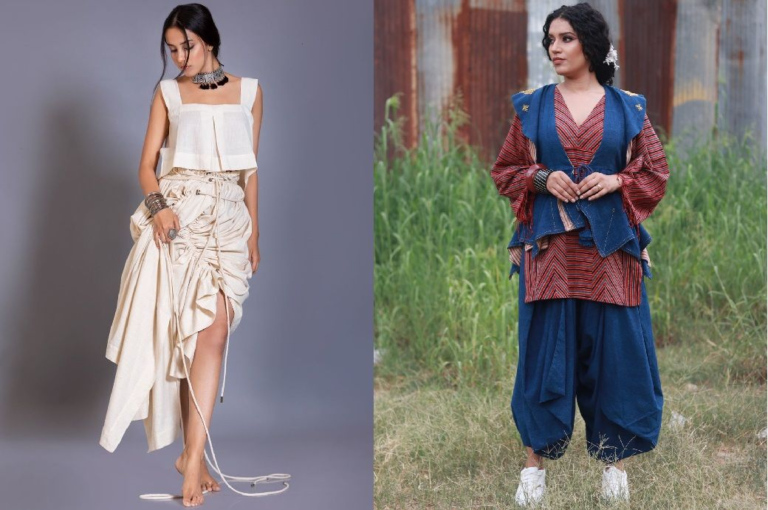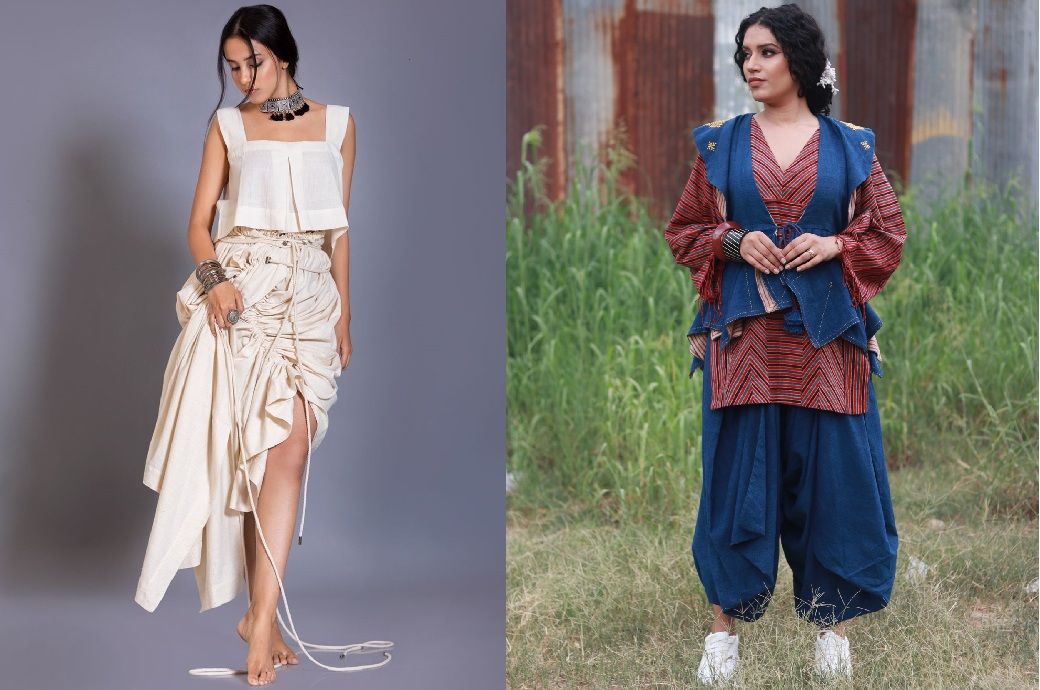
[ad_1]

The following students presented their collections at the pioneering event.
The GFWi was held for the first time in India and was hosted by fashion design school Pearl Academy at the FDCI x Lakmè Fashion Week. Twenty-seven colleges had participated in the mega event with 150 collections. The alumni showcased collections featuring genderless garments to different aspects of Indian aesthetics that coincide with life’s struggles.
“My graduation project’s concept is ‘APOC’ A.K.A ‘a piece of cloth,’ derived from the Indian drapes of the saree, dhoti, etc. A saree or dhoti is essentially 6 meters and 3.5 meters of rectangular unstitched cloth respectively, wrapped, tucked, and pleated around the body. The collection is an avant-garde take on Indian drapes, so I wanted to use the same length of traditional drapes and create pieces that work for a younger, contemporary audience,” Radhika Kulwal said in a press release by Pearl Academy. “I engineered casings to gather and ruche fabric at strategic places; thus, creating a new shape/form each time. The openings for the neck and limbs have been developed keeping in mind the multi-way wearing capability. The textiles are an ode to Indian handloom weavers. I sourced khadi in various yarn counts and weaves. The slips for diaphanous and fine calico silhouettes have been developed using zero-waste pattern cutting. The concept of drawstrings was reimagined as tie cords and the ends of the cords have toggles to control the tying of the material.
“The Re-gender-De-gender collection was all about creating genderless garments with an amalgamation of Indian and streetwear aesthetics. The collection has an avant-garde take on the upliftment of Indian crafts and presenting it on a global level. The concept of re-gendering and de-gendering was derived based on the observation of how gender rules have been assigned and visually depicted from the craft of Phad painting. The collection was inspired by Phad painting, which has been incorporated in terms of graphics, silhouettes, and fabric choices,” said Devanshu Bawa. “Pattern making used in the garments was the Indian way of garment construction. All the graphics made for this collection were contemporary versions of Phad paintings, which have been made through various modern techniques like collaging, juxtaposition, etc. For curating the Indian essence for streetwear looks, 30 voiles for the bottom layer and nylon taffeta for the top layer were chosen for quilting the fabric.”
“The Looking Back in Time collection focuses on a new perspective on craft, the Mizo craft of making hand woven fabrics called puan. Colour palettes and silhouettes were derived from the Grand Budapest Hotel movie,” said Josephine. “This led to the development of new textiles using traditional Mizo hand weaving looms, in never done before materials and techniques and incorporating them in zero waste silhouettes to present a line that has the essence tradition with all its patina yet something new.”
“The theme ‘Ra.Sa : Engineering Emotions’ is a journey undertaken to different corners of India, while talking about myths, tales, and emotions developed along the way. Rasa is the pleasure that one gets after looking at something — be it a negative or positive emotion. The concept is an amalgamation of bhava and architecture. Each stage or rasa depicts Indian history from its struggle to the time it has found balance,” said Harshika Chopra. “Each stage reflects a tale, a story that unites with the journey of life. It showcases how one’s personality undergoes a change or transformation from its raw self with the course of time. It overpowers the theory of choice that plays a dual role in one’s life and thus engineers emotion.”
“Deeply rooted in Indian aesthetics, the project is an ode to Indian culture and craftsmen. The concepts speak about ‘rasa,’ the intangible aspect and ‘kala,’ which is the tangible aspect in Indian aesthetics. This has been translated by studying architecture forms and breaking them into shapes which were juxtaposed for extracting panels. The journey is realised through traditional pattern-making techniques and various indigenous techniques of surfaces, embellishments, and trims. Re-construction and re-imagining of garments to derive modern silhouettes that align with the architecture form, the location, and the rasa is a perfect synthesis of culture. The idea realised is to make a concoction of different arts and crafts from different regions. To tell the story of the land via a garment, objects have been procured from or influenced by different regions. Handwoven indigenous cotton from the East and South, the base fabric-surface Ajrakh print from the West, Soof embroidery from the North, and braiding trim details from North-East India has been fused together in a garment to portray the united self of different regions, history, and emotions,” added Chopra.
Fibre2Fashion News Desk (NB)
[ad_2]
Source link